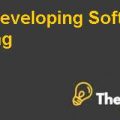Project Angel Case Study Analysis
What are the key issues and risks affecting the Company, the development plan and the investment returns?
Since the decision of acquiring the company would be financed from debt, this will increase the finance cost and debt level of the company leading todecline in profitability. In addition, financing the deal with debt will ensure that the shareholdingstructure of the organization is not diluted and will be a cheaper source of finance as tax reliefare provided on debt finance.Additionally, the liquidity risk could hinders the power of the company to sell the investment at the relatively fair price. Furthermore, the market risk is another issue due to which the fluctuation in the market tends to last adverse impact on the value of the investment held in the portfolio. The operational risk could be incurred as a result of inadequate systems and processes supporting the organization.
What are the special key items for due diligence?
The due diligence checklist before making decision of acquiring the company should include the critical investigation and assessment of the products and customer data, employee relation operational performance, legal issues and financial documents. The operational and technical due diligence should be based on attaining the in-depth knowledge and understanding of the business and its assets whereas the due diligence of the legal and contingent obligations should include the identification of the key deal issues and determination of possible reduction in the purchase price. Additionally, the strategic due diligence would provide Bridgepoint a solid foundation of testing the strategic rationale behind the proposed transaction as well as analyze whether the deal would be feasible and viable and whether the target value would be realized. Along with this, the market due diligence would add value to the decision of purchasing a company on the ground that the company would have extensive knowledge about the market attractiveness, key competitors and their value proposition, key evolving trends etc.
What are the issues in the sale process?
There are various issues while contemplating to sell the business to another party such as; determination of the range of the value of the business, improving the value prior to the sale of the business, identify the potential buyers and qualify them and lastly dealnegotiation in effective manner. The decision of selling the business is complicated and complex task to be done in effective way as it involves the detailed assessment of the potential buyer, standing and position of the company in the market and the range of the value. To make the deal successful, it is of paramount importance to resolve the issues in the sale process.
What is Bridgepoint’s expected ownership timeline and likely exit?
The ownership timeline of the company depends upon how well the business performs in the short run and long run. The consolidation by the strategic purchasers is not tied to the ext strategy, however, the IPO roll ups and leveraged build-ups by the private equity firms with dedicated fund raised from the investors with the time bound and fixed investmenthorizons tends to require the predictable exit strategy with core consideration of convincing those investors (Sudarsanam, 2003). The lenders to these consolidation might demand a distinct exit strategy. The market conditions determine the method of the exit strategy either via IPO or a secondary buyout by another private equity firm. Generally, the private equity investors tends to have the 5 to 7 years of investment horizons and plan an exit strategy after making substantial profit on the investment. The most considerable component of the exit preparation strategy is consistently honing an evidence-backed, well-articulated and well-developed view of why an assets represents a feasible investment opportunity (Guillaume Cazalaa, 2019).
How did you come to your Enterprise Value for the business?
Angel
The enterprise value for the Angel group is calculated by multiplying the earnings before interest, tax, depreciation and amortization at December 2010 at SEK 271 million by the implied multiple of 5x. Thus, the enterprise value or proposed transaction value is calculated SEK 1355 million.
Charlie
The enterprise value for the Charlie Company is calculated by multiplying the earnings before interest, tax, depreciation and amortization at 2010 (F) at 47 million euros by theaverage EV/EBITDA of multiples at 2010 (E)of 5.9x. Thus, the enterprise value or proposed transaction value is calculated 277 million euros.
Final optional questions for the consideration of students with a background in finance or M&A. Please consider:
What would be the split of equity funding by Bridgepoint from its fund ‘BEIV’ and externally sourced debt in financing the acquisition?
The split of the equity funding by the Bridgepoint from its fund ‘BEIV’ and externally sourced debt in financing the acquisition is 15 percent and 85 percent respectively. The split of the equity and debt is based on the fund value of the Charlie Company which is 277 million euros. As per the information provided in the case, the favorable indication of support have been obtained by Members of Bridgepoint’s Frankfurt team for the provision of the acquisition finance debt for possible acquisition of Charlie totaling 235 million euros which is accounted for 85 percent of the debt financing of enterprisevalue of Charlie whereas Bridgepoint contemplated to invest at least 100 million euros equity in the transaction, but no more than 500 million euros due to which the split of 15 percent equity totals 41.595 million euros which is significantly lower than the proposed maximum range of 500 million euros. In doing so, the split of the equity is below the maximum range of 500 million euros and the split of debt is equivalent to the available acquisition facilities by bank amounted to 235 million euros.
What investment returns might Bridgepoint expect to obtain on its equity based onthis financial structure, expressed as both MOIC (Multiple of Invested Capital) and IRR (Internal Rate of Return)?
By assuming that the investment of 277 million euros would yield a cash flows of 250 million euros each year for the next five years, the total value that the company would generate would amounted to 1250 million euros at the end of the fifth year, the multiple of the invested capital is calculated by dividing the invested amount of 277 million euros by the total value generated at the end of the fifth year which is 1250 million euros, the Multiple of Invested Capital is 4.5x which means that the return on the investment of Bridgepoint would be 4.5 times of the invested capital. On the other hand, the internal rate of return is also calculated as an indicator of the feasibility and profitability of the investment. The internal rate of return of the projected cash flows for 5 year is 86% which means that the investment would be offering 86 percent return over year.....................................
This is just a sample partical work. Please place the order on the website to get your own originally done case solution.











